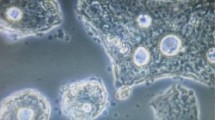Abstract
In order to examine a role of carcinoembryonic antigen (CEA) in metastasis, cDNA encoding CEA was introduced into a clone of human colorectal carcinoma SW1222 cells. Western blot analysis revealed that all transfectants express CEA of 180 kDa while the parent clone does not. In the transfectants, the level of CEA expression in clone 3 was higher than that of clone 1. Clone 3 formed aggregates rapidly after suspended by trypsinization while clone 1 did not. In experimental metastasis assay where tumor cells were injected intrasplenically, clone 3 exhibited a higher liver-metastatic activity than clone 1. Fab fragment of anti-CEA antibody significantly inhibited both the cell aggregation and the liver metastases caused by clone 3. These findings suggested that CEA expressed on the cell surface may play an important role in hepatic metastasis from colorectal carcinoma, possibly through its cell adhesion activity.
Similar content being viewed by others
References
Gold P and Freedman SO, 1965, Demonstration of tumor-specific antigens in human colonic carcinoma by immunological tolerance and absorption techniques.J Exp Med,121, 439–62.
Oikawa S, Nakazato H and Kosaki G, 1987, Primary structure of human carcinoembryonic antigen (CEA) deduced from cDNA sequence.Biochem Biophys Res Commun,142, 511–8.
Zimmerman W, Ortlieb B, Friedrich R and Von Kleist S, 1987, Isolation and characterization of cDNA clones encoding the human carcinoembryonic antigen reveal a highly conserved repeating structure.Proc Natl Acad Sci USA,84, 2960–64.
Beauchemin N, Benchimol S, Cournoyer D, Fuks A and Stanners CP, 1987, Isolation and characterization of full-length functional cDNA clones for human carcinoembryonic antigen.Mol Cell Biol,7, 3221–30.
Oikawa S, Imajo S, Noguchi T, Kosaki G and Nakazato H, 1987, The carcinoembryonic antigen (CEA) contains multiple immunoglobulin-like domains.Biochem Biophys Res Commun,144, 634–42.
Paxton RJ, Mooser G, Pande H, Lee TD and Shively JE, 1987, Sequence analysis of carcinoembryonic antigen: identification of glycosylation sites and homology with the immunoglobulin supergene family.Proc Natl Acad Sci USA,84, 920–24.
Benchimol S, Fuks A, Jothy S,et al. 1989, Carcinoembryonic antigen, a human tumor marker, functions as an intercellular adhesion molecule.Cell,57, 327–34.
Oikawa S, Inuzuka C, Kuroki M,et al. 1989, Cell adhesion activity of non-specific cross-reacting antigen (NCA) and carcinoembryonic antigen (CEA) expressed on CHO cell surface: homophilic and heterophilic adhesion.Biochem Biophys Res Commun,164, 39–45.
Humphries MJ, Olden K and Yamada KM, 1986, Synthetic peptide from fibronectin inhibits experimental metastasis of murine melanoma cells.Science,233, 467–70.
McCarthy JB, Skubitz APN, Palm SL and Furcht LT, 1988, Metastases inhibition of different tumor types by purified laminin fragments and a heparinbinding fragment of fibronectin.J Natl Cancer Inst,80, 108–16.
Roossien FF, De Kuiper PE, De Rijk D and Roos E, 1990, Invasive and metastatic capacity of revertants of LFA-1-deficient mutant T-cell hybridomas.Cancer Res,50, 3509–13.
Hostetter RB, Augustus LB, Mankarious R,et al. 1990, Carcinoembryonic antigen as a selective enhancer of colorectal cancer metastasis.J Natl Cancer Inst,82, 380–85.
Southern PJ and Berg P, 1982, Transformation of mammalian cells to antibiotic resistance with a bacterial gene under control of the SV40 early region promoter.J Mol Appl Genet,1, 327–41.
Kozlowski JM, Fidler IJ, Campbell D,et al. 1984, Metastatic behavior of human tumor cell lines grown in the nude mouse.Cancer Res,44, 3522–9.
Wagner HE, Toth CA, Steele G Jr and Thomas P, 1992, Metastatic potential of human colon cancer cell lines: relationship to cellular differentiation and carcinoembryonic antigen production.Clin Exp Metastasis,10, 25–31.
Steele G Jr and Zamcheck N, 1985, The use of carcinoembryonic antigen in the clinical management of patients with colorectal cancer.Cancer Detect Prev,8, 421–7.
Thomas P, Toth CA, Saini KS, Jessup JM and Steele G Jr, 1990, The structure, metabolism and function of the carcinoembryonic antigen gene family.Biochim Biophys Acta,1032, 177–89.
Updike TV and Nicolson GL, 1986, Malignant melanoma cell lines selectedin vitro for increased homotypic adhesion properties have increased experimental metastatic potential.Clin Exp Metastasis,4, 273–84.
Shuster J, Silverman M and Gold P, 1973, Metabolism of human carcinoembryonic antigen in xenogeneic animals.Cancer Res,33, 65–8.
Thomas P and Hems DA, 1975, Hepatic clearance of circulating native and asialo carcinoembryonic antigen by the rat.Biochem Biophys Res Commun,67, 1205–9.
Toth CA, Thomas P, Broitman SA and Zamcheck N, 1982, A new Kupffer cell receptor mediating plasma clearance of carcinoembryonic antigen by the rat.Biochem J,204, 377–81.
Bresalier RS, Hujanen ES, Raper SE,et al. 1987, An animal model for colon cancer metastasis: establishment and characterization of murine cell lines with enhanced liver-metastasizing ability.Cancer Res,47, 1398–406.
Author information
Authors and Affiliations
Rights and permissions
About this article
Cite this article
Hashino, J., Fukuda, Y., Oikawa, S. et al. Metastatic potential of human colorectal carcinoma SW1222 cells transfected with cDNA encoding carcinoembryonic antigen. Clin Exp Metast 12, 324–328 (1994). https://doi.org/10.1007/BF01753839
Received:
Accepted:
Issue Date:
DOI: https://doi.org/10.1007/BF01753839




